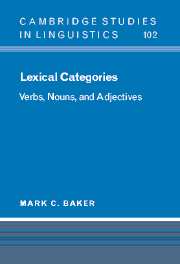Book contents
- Frontmatter
- Contents
- Acknowledgements
- List of abbreviations
- 1 The problem of the lexical categories
- 2 Verbs as licensers of subjects
- 3 Nouns as bearers of a referential index
- 4 Adjectives as neither nouns nor verbs
- 5 Lexical categories and the nature of the grammar
- Appendix Adpositions as functional categories
- References
- Index
2 - Verbs as licensers of subjects
Published online by Cambridge University Press: 06 January 2010
- Frontmatter
- Contents
- Acknowledgements
- List of abbreviations
- 1 The problem of the lexical categories
- 2 Verbs as licensers of subjects
- 3 Nouns as bearers of a referential index
- 4 Adjectives as neither nouns nor verbs
- 5 Lexical categories and the nature of the grammar
- Appendix Adpositions as functional categories
- References
- Index
Summary
Introduction
What is the essential property that makes verbs behave differently from nouns and adjectives in morphology and syntax? This question is perhaps the easiest place to begin, because there is an obvious starting-point in the widespread recognition that verbs are the quintessential predicates. They are inherently unsaturated expressions that hold of something else, and thus the nucleus around which sentences are typically built. Many linguists of different schools have recognized the significance of this. Among the formalists, Jackendoff (1977) partially defines verbs with the feature “+subject” (although this does not distinguish them from nouns, in his view). Among the functionalists, Croft (1991) identifies predication as the pragmatic function that provides the external motivation for the category verb. I argue for the precise version of this intuition stated in (1).
(1) X is a verb if and only if X is a lexical category and X has a specifier.
The discussion will unfold as follows. I begin by explaining why (1) is a plausible way of distinguishing verbs from other categories, and why it is more promising than some of the obvious alternatives (section 2.2). Next I explore (1)'s implication that predicate nouns and adjectives, unlike verbs, must be supported by a functional head I call Pred in order for the clause to have a subject (section 2.3), showing that this functional head is seen overtly in some languages (section 2.4). Even in languages where Pred is not realized phonologically – perhaps the majority – its presence can be detected by morphological tests; Pred frequently prevents categories other than verbs from combining with tense/aspect morphology (section 2.5) or causative morphemes (section 2.6), for example.
- Type
- Chapter
- Information
- Lexical CategoriesVerbs, Nouns and Adjectives, pp. 23 - 94Publisher: Cambridge University PressPrint publication year: 2003

